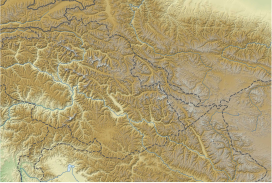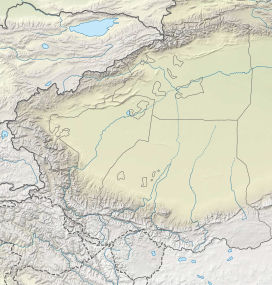Muztagh Tower
| Muztagh Tower | |||
|---|---|---|---|
| Simplified Chinese | 慕士塔格塔峰 | ||
| |||
Muztagh Tower (Urdu: مز تاغ ٹاور), also Mustagh Tower; Muztagh: icy mountain), is a mountain situated in Baltoro Muztagh, which is a segment of the Karakoram range. It straddles the border of the Gilgit–Baltistan region of Pakistan and the Xinjiang Uyghur Autonomous Region of China. Muztagh Tower is located between the basins of the Baltoro and Sarpo Laggo glaciers.[2]
Early prominence
[edit]
The Mustagh Tower gained attention through a photograph captured by Vittorio Sella during the 1909 Italian expedition to K2. The picture was taken from the upper Baltoro, from a vantage point located due southeast of the mountain. In this photograph, the twin summits of Mustagh Tower appeared perfectly aligned, giving the mountain the appearance of a slender tooth and making it seem extremely impregnable. This image was featured in a book on mountaineering in 1941 with the caption "The Last Citadel".[3]
First and second ascents
[edit]Nearly five decades after Vittorio Sella's photograph was taken, in 1956, his image served as inspiration for two separate expeditions that raced to achieve the first ascent of Mustagh Tower. Interestingly, both teams discovered that the mountain's routes were less steep than what Sella's photograph had suggested.[4] The British expedition, consisting of John Hartog, Joe Brown, Tom Patey and Ian McNaught-Davis, approached the peak from the Chagaran Glacier on the west side and successfully reached the summit via the Northwest Ridge on July 6.[5][6] They achieved this feat five days ahead of the French team, consisting of Guido Magnone, fr:Robert Paragot, André Contamine, and Paul Keller, who climbed the mountain from the east.[7] François Florence waited for the two parties at the camp IV during 42 hours without a radio, when they went, reached the summit and came back to this camp.[8]
Notable ascents and attempts
[edit]- 1984 Northwest Ridge 2nd of route, 3rd of peak by Mal Duff, Tony Brindle, Jon Tinker and Sandy Allan (all UK).[9][10]
- 1990 The fourth ascent was made by Göran Kropp and Rafael Jensen.[11][12]
A lower summit, 7,180 m (23,560 ft) was first climbed in 1984 by the northeast ridge.[citation needed]
- 2008 On 24 August 2008, the Northeast Face was climbed by two Slovenian alpinists, Pavle Kozjek and Dejan Miškovič. They bivouacked on the crest after 17 hours of climbing. They decided not to go to the summit because of strong wind. Just after they started descending, Kozjek fell to his death.[13]
- 2012 On the day of 25 August, 56 years after the day when the first man climbed to the top of this mountain, three Russians made an ascent by the centre Northeast Face. Sergei Nilov, Dmitry Golovchenko and Alexander Lange reached the top and made a new route. The ascent lasted for 17 days.[14][15]
See also
[edit]Notes
[edit]- ^ a b c Prominent Karkoram peaks on peaklist.org; Peakbagger reports 7,273 metres elev. and 1,707 metres prom.
- ^ "Muztagh Tower - Peakbagger.com".
- ^ Ullman, James Ramsey (1941). High Conquest: The Story of Mountaineering. J. B. Lippincott Co.
- ^ Curran, Jim (1995). K2: The Story of the Savage Mountain. Hodder & Stoughton. p. 66. ISBN 978-0-340-66007-2.
- ^ Hartog, J.H. (1956). "The climbing of the Muztagh Tower". The Alpine Journal. 61: 253–270.
- ^ Patey, Tom (1971). One Man's Mountains. pp. 135–147. ISBN 0-575-01358-3.
- ^ Magnone, Guido (1957). "The Muztagh Tower". Himalayan Journal. 20: 40–50. Retrieved 4 February 2020.
- ^ Jill Neate, High Asia: an illustrated history of the 7,000 metre peaks, The Mountaineers, 1989, ISBN 978-0-898-86238-6, pp. 117-118.
- ^ Duff, Mal (1985). "The Second Ascent of the Mustagh Tower" (PDF). The Alpine Journal. 90: 74–76. Retrieved 2011-04-13.
- ^ Greig, Andrew (1985). Summit Fever: The Story of an Armchair Climber on the 1984 Mustagh Tower Expedition. Hutchinson. ISBN 0-09-162060-0.
- ^ Kropp, Göran; Lagercrantz, David (2000). Ultimate High: My Everest Odyssey. Discovery Channel. ISBN 1-56331-936-5.
- ^ Nunn, Paul (1991–92). "Karakoram 1990" (PDF). The Alpine Journal. 96: 241.
- ^ "Interview with Dejan Miškovič (slovene language)". Sport1. 2008-09-12. Archived from the original on 2009-03-01. Retrieved 2008-09-16.
- ^ "Risk.ru - Музтаг Тауэр 2012. Экспедиция ФАиС г.Москвы. Вершина!!! (russian language)". Risk.ru. 2012-08-25.
- ^ "Short film about ascent (on english)". Archived from the original on 2013-07-30.





